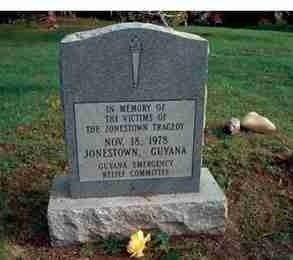I don’t believe I ever met the Rev. Jim Jones in person but the story of the man who established the Peoples Temple of Love in Indiana in 1955, relocated his followers to a South American jungle, then led more than 950 men, women and children to their deaths on Saturday, Nov. 18, 1978, continues to haunt me 40 years later.
Claiming political and media persecution, Jones moved his followers – more than three in four African American – from San Francisco to my native Guyana, believing it to be among the safest places for radiation fallout in the supposedly coming nuclear war. The Guyana government, fearing invasion by nearby Venezuela over a border dispute, saw advantage in having an American presence in the disputed territory.
Jones chose the Port Kaituma area about 120 miles from Georgetown, where he and his followers carved out a settlement, Jonestown, accessible mainly by a seven-mile dirt road leading to a small dirt airstrip. They built homes and cultivated produce under the Peoples Temple Agricultural Project. Jones also maintained a base at a house in Georgetown, where a small number of his followers, including his only natural son, Stephan, lived, and another in San Francisco, all linked by shortwave radio.
JUNGLE UTOPIA
His hopes for a jungle utopia freed from the world seemed on the way to being fulfilled. But he could not escape his past in California, where the media widely believed the Peoples Temple was not a church but a cult. The illusion was shattered when Leo Ryan, a California congressman, went calling. Ryan’s legislative counsel, Jackie Speier, told Roll Call that her boss wanted to check first-hand into constituents’ complaint that all was not well in Jonestown. He led a 24-person delegation to Guyana that included Speier and a handful of journalists and, after keeping him waiting two days, Jones approved the visit which took place on Friday, Nov. 17, 1978.
I was the Guyana reporter for the now defunct Caribbean News Agency (CANA) and more than eager to cover this big story. Speier gave the OK but, at the last minute, I was bumped from the plane to make way for a Guyana government information officer.
The next time I heard of Ryan was in a phone call from my editor, Hubert Williams, in Barbados, early that Sunday morning — when I was battling the flu and a high fever. Williams explained that the State Department had issued a statement saying that Ryan and several members of his delegation had been killed.
I would not sleep for the next 72 hours. After the killings, the government sealed off the settlement because of reports, which turned out to be false, that an armed team from Jonestown was on the loose. It was not until the next day that journalists were allowed in. The late Shirley Field-Ridley, then Minister of Information, picked me as the pool reporter to write stories for the Caribbean media and Charles Krouse, then with The Washington Post, for the international press. We arrived to a scene not exactly out of a horror movie and not bloody but one filled still with the silent kind of horror that takes some time to sink in, with even greater effect.
DEADLY CONCOCTION
In front of me lay the bodies of, it would emerge, more than 950 men and women and including 300 children, some stacked more than four deep. A man and a woman lay face down, their arms stretched across a child. I saw Jim Jones – for the first time, I believe – on his back, a bullet wound to the temple, a handgun close by. Near the steps of their makeshift temple lay his wife Marceline, among a small group of bodies, including some of the Joneses’ adopted adult children, all black.
Not far off stood an oil drum, cut in half, that still contained what turned out to be a deadly concoction of fruit drink laced with cyanide and anti-anxiety drugs. Later reports indicated the adults first squirted it into the mouths of the very young before drinking the poison. People magazine reported this June that defectors said Jones coaxed his followers to drink, admitting the brew contained cyanide but adding, “It’s not going to taste bad.” It is still not certain whether they were forced to do so at gunpoint in a mass murder or collectively agreed to mass suicide.
Jones was the only one among the dead who was shot but a few young women “aides” were found with shotgun wounds in one of the houses, according to those who saw them. The fact that the gun was a short distance from Jones’ body still fuels speculation that he was killed.
An open leather briefcase lay on the ground full of American passports, now in police custody.
I walked among the dead for a while and then just sat down on a tree stump and gazed in disbelief as I pondered on what in the psyche of some human beings would lead to this.
FIRST BYLINE
The government sent a smaller plane for the return trip and some of us had to wait until the morning but Krouse made it out. I spent the night at a nearby police station, where I was allowed to use the radio to file my story. I dictated it to my wife Enid at our home because the radio could not reach Barbados, where my editor was based. She then phoned it to him. So while Krouse was still in the air, I was getting the first byline on a story that was of worldwide interest.
Larry Layton, a Jonestown member, was being held in a cell just below the sleeping area and he ranted at the top of his voice the entire night, so I did not get to interview him. But, the next morning, I met and interviewed the only other immediate survivors, both elderly African Americans — a woman who told me she slept through the chaos of the night before and a man who said as Jones was persuading his followers that death was the only way out, he unobtrusively slipped away and hid in a dugout.
I also interviewed the district medical officer, who had rushed to the scene. He read off to me a list of powerful drugs found in the settlement that were most likely used to keep the people sedated and also to make the deadly mixture in the half-drum. By the time I was back in Georgetown, the story was being pieced together further. Speier recalled in the Roll Call story published on Nov. 18, 2015, that at Jonestown Ryan and his delegation were treated to entertainment while Jones’ followers were being interviewed. She said someone surreptitiously passed a note to NBC News reporter Don Harris which said some wanted to leave. Any façade of normalcy began to collapse but all was not yet lost.
REVOLUTIONARY DEATH
Jones said anyone wanting to leave was free to do so and they were driven with Ryan and his team to the airstrip. They would need two flights to take them all. Speier recalled that as she was getting people on board the first plane, a Guyanese child ran up to her. (Several dozen of them were in Jonestown to attend the school which Jones ran.) As Speier was trying to coax the child to leave, she said, a tractor-trailer drove up and shooting began at point blank range. “People ran into the bush. I followed Ryan under the plane and hid under one of the wheels,” she said.
Ryan, shot in the head, Harris and three others were dead. Speier was hit five times, spent two months in hospital and underwent 10 surgeries.
Later news reports filled in the blanks. Ryan had seemed impressed with Jonestown even after several members wanted to leave. But a Jonestown follower lunged at him with a knife and cut him in the arm. The damage was done; an attempt was made on a congressman’s life.
Jones evidently realized this and prepared his followers for the worst. Some reports said while Ryan and his delegation and the defectors were on the way to the airstrip, he called his followers to the meeting place and told them he prayed for a miracle and Ryan’s plane would fall out of the sky.
Apparently a handgun was hidden under a seat behind the pilot and Layton reportedly was to sit there and shoot him, causing the plane to crash. But the gun was discovered and Layton was apprehended. Jones then went into his final sermon. People magazine reported survivors as saying he saw death as a “revolutionary” act and that, “If we can’t live in peace, then let’s die in peace.”
SOVIET EMBASSY
Jones dispatched a hit squad which shot Ryan and others. In the Georgetown location, on receiving a kill code, a mother had another follower slit the throats of her two daughters while she held them down and then herself.
Survivors Tim Carter, then 30, and his brother Mike Carter, 20, and Mike Prokes, 31, helped me understand further what happened. A Jones aide, Maria Katsaris, had instructed them to take a briefcase containing an estimated $500,000 and “two or three notes” to the Soviet embassy in Georgetown. That opened another intriguing angle to the tragedy. Apparently Jones was worried that the Guyana government planned to expel him and he was planning to relocate, once again, this time to the then Soviet Union.
The Carters and Prokes eventually encountered a policeman, who took them into custody, and they finally ended up at a Georgetown hotel.
“I don’t know how history would judge Jim Jones,” Tim Carter told me at the time. “What happened was grotesque, totally unnecessary and a waste. But the story of Peoples Temple is such a complex one, so many different variables involved, leading to this final act of insanity.”
Mike Carter blamed “isolation” for the tragedy, saying it was one of its main weaknesses. Tim agreed: “Jones so isolated himself that he lost his perspective.”
Prokes said Jones had been making a genuine effort to create something worthwhile but it failed because of “a conspiracy” to destroy him and his movement.
IMMEASURABLE GRIEF
The three men said none of Jones’ followers expected to die. “There is 60,000 board feet of lumber now lying on the Port Kaituma dock,” said Tim. “You don’t order 60,000 board feet of lumber if you are going to die.”
“You don’t spend $7 million on a project, a model community, and then kill yourself,” Prokes added.
By the end, 50 cottages had been built, with seven couples living in each, and plans to construct another 150, eventually having only two couples per house.
The Carters and Prokes told of immeasurable grief as they got ready to carry out their mission. Tim Carter said as he went to say goodbye to his wife Gloria, “She was kneeling on the ground and she was holding our son and I saw tears flowing down her cheeks. I don’t know, I can’t imagine, what was going through her head. I came up to her and looked down and said, ‘Our son is dead.’ I leaned over and hugged her and said, ‘I love you so much. I love you. I love you. I love you.” Gloria then went into convulsions and fell next to their 18month-old child.
Mike Carter said his wife Jocelyn, 20, and their 15-month-old daughter also died. So too did the Carters’ sister Terry and Prokes’ adopted son Randy, three-years-old.
Jonestown finally ended for Prokes in a Modesto, Calif., hotel four months later. According to the website Alternative Considerations of Jonestown & Peoples Temple, maintained by San Diego State University, he called a press conference, read a statement, went into the bathroom, closed the door, turned on the faucet and shot himself in the head.
A note found next to Prokes’ body read, “Don’t accept anyone’s analysis or hypothesis that this was the result of despondency over Jonestown. I could live and cope with despondency. Nor was it an act of a ‘disturbed’ or ‘programmed’ mind – in case anyone tries to pass it off as that. The fact is that a person can rationally choose to die for reasons that are just, and that’s just what I did. If my death doesn’t prompt another look at what brought about the end of Jonestown, then life wasn’t worth living anyway.”
POSSIBLE CIA INVOLVEMENT Speier told Roll Call that the State Department should have paid more attention to Jonestown, especially after Layton’s sister Debbie, who fled the settlement, told the U.S. embassy in Georgetown that there were problems at the settlement.
Speier added, “There were some that had suggested that the CIA was somehow involved and they didn’t want that to be exposed.” I too had heard similar speculation. Speier, who was elected to Ryan’s congressional seat in 2008 and is on the House Intelligence Committee, said she requested the Jonestown documentation. “It does not appear that that was the case. And I don’t know,” she added. “But it does seem like it was mishandled on a number of levels.”
Speier said the State Department “could benefit from doing a case study” of Jonestown, loosely quoting the Spanish philosopher George Santayana, “If you don’t learn from your mistakes, you’re condemned to repeat them” — which, ironically, was written in bold letters on a sign nailed to the Jonestown meeting place.
I returned to Jonestown a week later. The produce garden was a bit less green and there was, ironically, a sign warning that fertilizer had been applied. A towering windmill still whirred overhead. Strewn around the settlement were hundreds of pieces of paper with expressions of affection for Jones written by his followers.
The bodies still lay in the hot tropical sun, decomposing now as the Guyanese and American governments squabbled about responsibility for burying them, until they were eventually taken to now Cheddi Jagan International Airport to be flown to Dover Air Force Base. At the airport, I saw Jones for the second time, his body now in a crude box on which was scribbled “Jimmye Jones.”
The American cult leader who fled San Francisco with his followers to escape perceived media persecution for a country he believed safe from radiation fallout in a coming nuclear war was on the way home.













No Comment